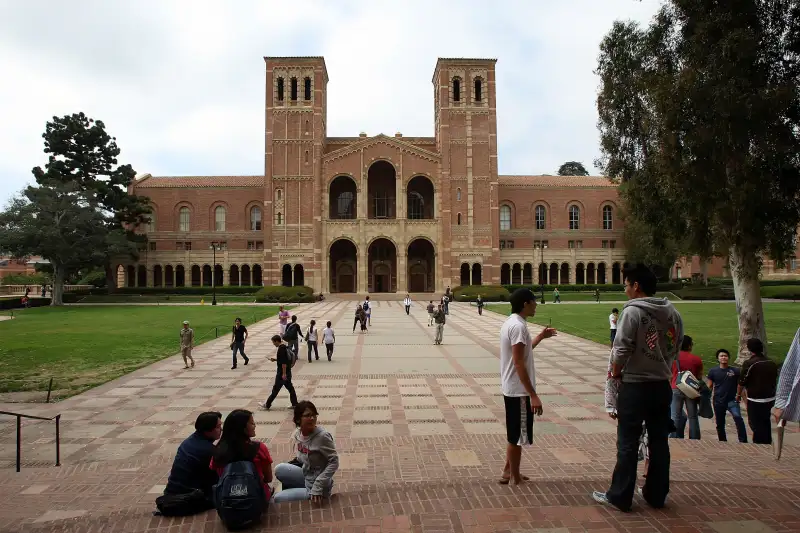Why an Out-of-Stater May Be Taking Your Kid's Seat at State U.

State universities historically served the public good, offering a college degree to a broad swath of residents and paving a path to the middle class for low-income families.
But a paper out today from New America says the nature of state universities is changing—for the worse.
Driven by a desire for dollars and higher rankings, public colleges are increasingly using their financial awards to recruit affluent out-of-staters instead of helping needy state residents attend college, the report charges.
As a result, writes author Stephen Burd, public colleges are losing sight of their public mission.
An analysis of non-need-based aid at 424 public four-year colleges found that schools that provide large amounts of merit aid have seen a greater drop in enrollment of in-state freshmen since 2000 than colleges that don’t award much merit aid.
Those colleges also tend to enroll fewer students with Pell Grants and charge low-income students a higher average net price. (In this case, merit aid is defined as any aid that’s awarded to students who don’t meet federal guidelines for need-based financial aid.)
Burd identifies several factors driving the trend. Some colleges, especially after seeing their state allocations cut during the economic recession, need the higher tuition that out-of-state students provide to meet their bottom line.
At the University of South Carolina, for example, the state has cut its annual funding to the university by 50% since 2007. This year, out-of-state students had a sticker tuition price of $29,372, compared with $11,128 for in-state students. Offering an out-of-state student a $10,000 tuition discount still generates more tuition revenue for the university than it would get by giving that seat to a state resident.
“Now we’re becoming more like the private schools in the way we approach admissions,” said Scott Verzyl, an associate vice president for enrollment management, who was quoted in the report. “We’re more in the mode of hustling for business and trying to find new markets.”
Nonresidents now compose 45% the University of South Carolina’s freshman class—more than double what it was in 2000.
Other universities use institutional aid to recruit high-achieving students to help it climb up college rankings lists, or to offset the decline in the number of high school graduates in some parts of the country. In some states, such as Missouri, colleges started directing their aid money to high-achieving in-state students to keep them from being poached by other states, the report notes.
Competition has grown so aggressive that even small, regional universities that once filled their seats with students from a limited geographic area are feeling the pressure. “Everyone’s territory appears to be becoming everyone else’s territory, to the point that we don’t have a territory, really,” said Thomas J. Calhoun Jr., a vice president for enrollment management at the University of North Alabama, in the report. “It has created the need for us to redefine what our region is."
Almost one in five public colleges gives merit aid to at least 20% of freshmen, and nearly half provide merit aid to at least 10% of freshmen, the analysis found.
The idea of an “aid arms race” isn’t new to higher education insiders, and the paper cites other media reports and policy studies that have examined the issue at the university level.
The problem is there’s little incentive for any one institution to unilaterally stop the practice. And so colleges have continued increasing the dollar value of their awards to meet their goals, creating a self-perpetuating cycle.
An Inside Higher Ed report on a recent analysis from Moody's captures the pressure public universities are under: "Universities that have greater flexibility to adjust revenue, such as through tuition increases and growth in out-of-state enrollment" stand the best chance of outperforming their peers in a particularly tough higher education market.
One could argue that filling up seats with nonresidents who still pay a significant amount of tuition produces revenue that could then help subsidize the cost for low-income students.
But the New America report notes that there are concerning trends linking merit aid and low-income enrollment, even if there isn't enough data to prove an increase in merit aid is directly responsible for freezing out low-income students.
For example, Pell Grant recipients made up about 32% of the student body at schools that provide a lot of merit aid, compared with 42% of the student body at low merit aid schools.
Likewise, at schools where merit aid is given to at least a quarter of incoming students, the freshman class is made up of about 28% out-of-state students. But at schools that don’t award much merit aid, nonresidents comprise just 10% of the freshman class.
